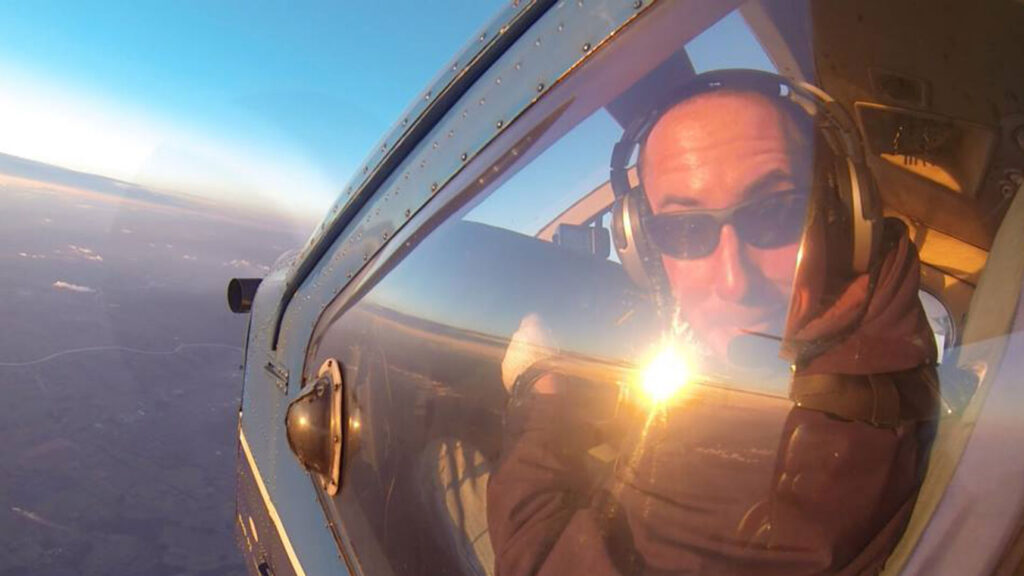The latest episode in our ‘Working in the Sport’ series, Simon Brentford, world medallist with NFTO, talks about how to become a camera flyer...

Photo: Author Simon Brentford filming a big-way camp at Skydive Hibaldstow by Alex Potter
There’s lots of great reasons why I love being a camera flyer, but one of my favourites is that there are always lots of teams and events to shoot.
Skydivers always appreciate a well-filmed jump showing them how cool they are! Camera flying expands your windows of friends, dropzones, teammates and glorious experiences.
Skydivers always appreciate a well-filmed jump showing them how cool they are!
This article shows you how to get into camera flying with as little as 200 jumps and a small budget. We’ll start with part one, which concerns itself with which type of skydiving you want to pursue and those first intrepid steps into a new discipline. Part two will talk about how to specialise and come up with strategies for advancing your skills.

Photo by Martin Skrbel
Which type of camera flying do you want to do?
This is the first question that needs to be asked and helps to define how you should structure your training. For most people, I suspect it will be along the lines of “I want to try everything”, or, “I’m not sure what I want to do yet”.
For others, it will be becoming a tandem camera flyer like Debi Debs, an up and coming UK camera flyer :
Debi Debs
I got a camera on my head on jump 201, but started filming tandems around 350ish late last year. It’s what I always wanted to do since jump number 1. It was a tandem jump and seeing the camera guy filming my tandem climb out like a superhero. I just thought he had the best job ever!
For others, it’s about jumping with your friends, be that formation skydiving or freefly. And then there are those who want to skydive as much as they can for as little outlay as possible.
Lastly, there are those that have a competitive streak running through them and flying camera on a team that trains is really their thing – much as I hate pigeonholing, I am probably matched here!

Your first 20 Camera Jumps
If you’ve decided to get into cameraflying, or at least give it a go, here’s some top tips I thoroughly recommend for your first 20 jumps:
Keep it Safe
First things first, let’s make it safe. Don’t just plonk a GoPro with a standard clip on the top of your lid. Go for low-snag mount. Also remember when you are camera flying, keep your head down on deployment. Make sure, you’re also wearing an audible and don’t lose altitude awareness. It’s ok to do your normal alti checks.
Get someone to check your camera setup before your first jump. This is especially true if you jump at a dropzone or country where you can put a camera on with less than 200 jumps.

Photo: Author Simon Brentford by Joe Mann
Practice
Before your first camera jump, put your helmet on to film a few test clips looking at something nearby on the ground. This will help you dial in where to point your head. Review your footage a few times to see how you’re doing. Practice switching your camera on whilst it’s on your head and whilst wearing gloves.
Mind The Step!
The camera step can be a daunting place if you’re not used to it. It’s easy to get a team in the face and if you’re unlucky (and I’ve seen it a few times), you might even fall off. So do some practicing on the ground. Expect the camera step not to be visible from the float rail and likewise expect to be pushed backwards. You can pin yourself to the side of the fuselage to reduce your drag.

Photo: Simon exits from the step with perfect timing
Photo by Glen Lowerson
First Jump – Keep it Simple
To start with, I would recommend a simple follow out with a couple of friends. Set your audible higher, so you can track off a bit earlier. Wear your normal jumpsuit.
Beware of Target Fixation
Returning back to the subject of safety, avoiding target fixation must also be one of your priorities for those early jumps. It’s easy to get far away from the group and then overamp your track back to them. Taking out your buddies halfway through the jump is not going to help anyone, not least your own confidence. Discovering the correct distance takes many jumps! Take your time.
Enjoy!
Lastly, enjoy those first few jumps. Yes, the footage probably won’t be great, but you’ll learn quickly. Expect to be a bit nervous, but enjoy your new-found bragging rights as you post it all over social media!

Photo: Simon filming NFTO, by Joe Mann
Camera and Helmet Setup

Knowing how to setup your camera can take some time to hone in. But these tips will definitely help in your configuration settings:
- Choose a low video resolution like 1080p and shoot at around 30 frames per second. 4k is rarely needed and will gobble up your hard drive space.
- Set your camera to a middle Field Of View (FOV), not too narrow or super wide.
- Disable the auto shutdown feature. It’s a common habit early on to power your camera on far too early and then it shuts down just before you want to hit the record button.
- Make sure it’s set to record the correct way up. Shooting upside-down footage is only going to make people laugh in the bar. I’ve done it!
- Initially, don’t worry about having a ring sight, or even a marker on your goggles / visor.
- Having a cutaway is highly recommended and in many countries is compulsory.
- Lastly, I’ll mention it again, spend your money on an anti-snag mount. Having lines wrapped around your head is a terrifying thought.
spend your money on an anti-snag mount

Photo: Martin Skrbel
Early Progression
With so many variables of subject, equipment familiarisation and weather, how are you to make those early first steps towards consistency and some usable footage?
The first thing to say, is find your buddies at your local dropzone and get them to buy into your training plan. Concentrate on them for those early jumps, learning how they fly, how they key their exits and how they get together.
Write some notes for improvement in your logbook along the lines of “went too early, went low, footage was shaky, flying too flat, switch camera on later, wear a slower jumpsuit, etc.”
Finding a local DZ camera flyer with experience who can take a look at your footage is going to help. Don’t wait until the end of the day to show him or her all your jumps, show them quick clips inbetween your jumps to maximise your performance.

Photo by Simon Brentford
Summary of Part One

Ultimately, the objective of your first 20 camera jumps is to get used to pointing your head at a subject whilst still maintaining altitude awareness. By the end of your 20 jumps, you should start to gain some consistency in terms of distance, filling the camera frame, understanding exit timing and even steepness of camera angle if you are on the ball.
You’ll already be attracting a new fan club and the monetisation of your first YouTube vids will be earning you a few pennies! 😉 Just kidding, in reality you’ll have learned to be safe wearing your camera and have worked out if this is really something you want to pursue.
Check out Simon’s second article where he shows how to move towards specialisation in your chosen camera discipline(s).
Working in Skydiving Series

Here are other articles aimed to help you work in your chosen area of the sport:
- So, you wannabe a Freefly Coach?
- So, You Wannabe a Skydiving Instructor?
- So, You Wannabe a Jump Pilot?
- So, You Wannabe a Rigger
- So, you Wannabe a Cameraflyer – part 1 and part 2
- So, You Wannabe a Canopy Piloting Coach
- So, You Wannabe a Packer
- Stay AWAKE, Stay ALERT! - 20th July 2022
- So You Wannabe a Cameraflyer – Part Two - 30th May 2022
- So You Wannabe a Cameraflyer – Part One - 30th May 2022
- Planning a Team for Next Year - 28th October 2021
- Mind the GAP! - 5th August 2021
- Return to the Sky - 23rd April 2021
- Community Eyes - 16th July 2020
- When the Poop Hits the Fan - 28th November 2018
- Stay AWAKE, Stay ALERT! - 20th July 2022
- So You Wannabe a Cameraflyer – Part Two - 30th May 2022
- So You Wannabe a Cameraflyer – Part One - 30th May 2022
- Planning a Team for Next Year - 28th October 2021
- Mind the GAP! - 5th August 2021
- Return to the Sky - 23rd April 2021
- Community Eyes - 16th July 2020
- When the Poop Hits the Fan - 28th November 2018

